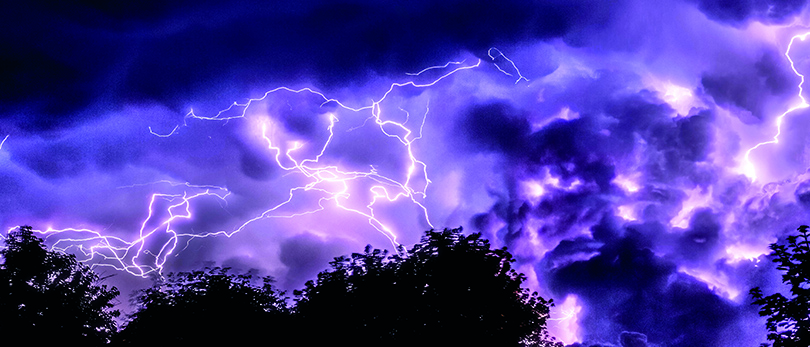Definition of brontophobia, the fear of thunder
Often associated with astraphobia, which is the fear of thunderstorms, or kerunophobia, the fear of lightning, brontophobia is the excessive fear of thunder. It is one of the ten most common phobias in the world and affects not only children, but also adults and animals.

Most of us startle at the rumble of thunder and do not develop other symptoms. However, the opposite is true for people with brontophobia, for whom the fear is uncontrollable. They are not always able to calm their fear and, without help, they feel completely threatened during storms. This phobia is more common among children.
Brontophobia in children
First of all, it is important to realise that the vast majority of children are afraid of storms. This is a normal reaction, as these are natural phenomena that can be very frightening for them. Even if a storm does not usually last very long, the strong wind, the lightning, the darkening of the sky and above all the sudden thunder are more than legitimate reasons to frighten anyone, especially if they do not understand what is going on – which is generally the case for children.
Therefore, it is not uncommon to see a child screaming, crying, or hiding under the bed to escape the storm. These behaviours are manifestations of the intense anxiety that the child feels when lightning strikes. Sometimes this can even lead to a panic attack. To avoid this, it is essential to reassure your child with comforting words and to make him/her understand that thunderstorms are a natural phenomenon that presents risks, it is true, but that one can easily protect oneself from them.
To do this, it may be useful to start by offering a rational explanation adapted to your child’s level of understanding, namely that a thunderstorm is a meteorological phenomenon in which the cumulonimbus – the “big clouds” – become charged with an electrical voltage attracted to the earth, producing an electric arc between the sky and the ground. Explaining is unfortunately not enough to bring down the anxiety sufficiently, so it is also necessary to create a diversion. A very good way to do this is to calculate together how far away the storm is from where you are by counting the number of seconds between the lightning and the thunder and multiplying this number by 350, which is the number of metres the sound travels in one second. The most important part of this reassurance is to listen and take into account the emotions your child is expressing. Acting as if this anxiety is totally irrational because there is no reason to fear the storm can quickly prove to be counterproductive and encourage avoidance in the child, which could then lead to the development of a real phobia in the near future.
However, this reassuring posture can be difficult for many parents to adopt as many adults also have a deep-seated fear of thunder and storms.
Brontophobia in adults
If this is your case, consoling a child in a storm will indeed be particularly complex because although your words may emphasise the positive outcome of the situation, non-verbal language will tend to betray your real emotions. Therefore, if you also feel an irrepressible need to flee and very distressed even when you are completely safe, you are most likely brontophobic.
The symptoms of fear of thunder
People who suffer from brontophobia are often filled with anxiety during thunderstorms, even if they are safe in their homes. Like most phobias, panic attacks, crying, sweating and rapid heartbeat can occur when the person is in the grip of their fear.
What is unique about brontophobia, however, is that most brontophobes will seek out company to reassure them during a storm. This can greatly reduce the severity of their symptoms. People with brontophobia may also try to hide from a storm, by covering their ears or climbing into cupboards. They will also pay attention to the possibility that a storm is approaching much closer than other people, feeling an impending sense of dread that is likely to make their symptoms worse.
The symptoms caused by brontophobia are numerous:
- Anxiety during storms
- A strong interest or even obsession with monitoring weather patterns
- The need to seek company during a storm
- The desire to hide from the storm
- The refusal to leave one’s home because of the potential danger of storms.
In extreme cases, brontophobes may become obsessed with watching weather reports and tracking storms in rainy weather. Sometimes they may even refuse to leave the house without first checking the weather to see if they will be safe. International pop star Madonna, for example, has admitted to being highly brontophobic. She says she cannot take part in an outdoor concert until she has consulted several weather reports from different sources confirming that there will be no storms.
Thus, the fear of thunderstorms can even lead to a kind of agoraphobia, where the person suffering from brontophobia refuses to leave her house because no other place is safe. Panic attacks can also have a detrimental effect on a person’s body, with symptoms worsening over time if not treated properly.
Combating brontophobia
Distraction is often the first key to treating brontophobia, which is one reason why having company during a storm can help alleviate the symptoms. If the phobia is more severe, professional help may be needed.
Cognitive and behavioural therapies (CBT) are the most effective treatment approach. With the help of the therapist, the person with brontophobia gradually frees himself from his fear. CBT works on two essential fronts. On the one hand, the brontophobic individual is gradually exposed to the object of his or her phobia to enable him or her to become accustomed to and desensitised to the sight of a storm, which will then no longer provoke the disproportionate emotional reactions as before. The therapist also works on the irrational beliefs, the automatic and catastrophic thoughts that arise each time a storm is mentioned, because it is these deep-rooted ideas that mainly motivate the fear.
Virtual Reality Exposure Therapies (VRET) to treat brontophobia
However, confronting the brontophobic person, even gradually, with the storm can be complicated on a practical level but also because of the intense anxiety felt. Virtual reality offers a relevant alternative to overcome these difficulties. It works on the same principle as CBT by seeking to make the fear reactions to the storm disappear completely through repeated exposure. To do this, the individual will be immersed in a fully recreated virtual world where he or she can, with the help of the therapist, effectively implement emotion management techniques such as relaxation using breathing exercises that can be mobilised in a virtual environment as well as in reality. Virtual reality therapies therefore enable the patient to regain confidence in his or her ability to face this type of situation and to regain freedom from the phobia.
What to do in the event of a storm
There are a few rules to be aware of in the event of a storm to ensure that you are completely safe and to help control your anxiety. These recommendations are based on the following two central principles:
- Lightning always seeks the shortest route to the ground. It therefore strikes anything that sticks out
- Conductive materials struck by lightning can electrocute you.
Therefore, in stormy weather, it is strongly advised:
If you are outside :
- Do not use an umbrella, especially one with a metal shaft
- Do not take shelter under a tree
- Keep as far away as possible from metal structures and bodies of water
- Avoid running
- In groups, spread out as much as possible.
By car: you are completely safe inside the vehicle. If the storm is accompanied by heavy rain, you can pull over and wait for the storm to pass.
At home, baths and showers should be avoided during the storm. You can unplug household appliances to avoid the risk of a power surge.


